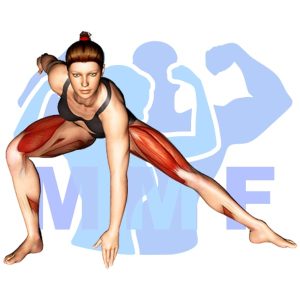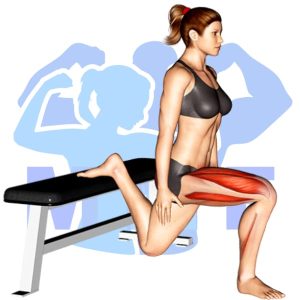Are you struggling to get that perfect squat form? Do you feel like your knees are caving in or your back is rounding when you try to perform a squat with weights? Don’t worry, you are definitely not alone. The traditional squat can be challenging, and not everyone has access to weights or a gym. But fear not, my friends! The solution to your problem might just be resistance band squats. In this post, we will go over the benefits of using resistance bands, common form mistakes, and tips on how to perform resistance band squats properly to improve your squat form and give you a great workout.
Resistance Band Squats Summary
- Primary Muscles: Quadriceps
- Secondary Muscles: Adductor Magnus, Gluteus Maximus, and Soleus
- Equipment: Resistance Band
- Mechanics Type: Compound
- Force: Push
- Utility: Basic

Resistance Band Squats Instructions
- Setup for squats by holding the resistance band handles in both hands and laying the band on the ground. Then step on the band with your feet.
- Squat down and ensure that the bands are tight when you are at the bottom for increased resistance. You can push the bands up with your arms until they are tight, pull some of the band between your feet.
- Now, from the squat position press back to a standing position with your quads and glutes. You should maintain the resistance bands in a vertical line from the floor throughout the squat.
- Repeat your squats for 8-12 reps.
Video Tutorial
Resistance Band Squats Muscles
Target (Agonist)
Synergists
- Adductor Magnus
- Gluteus Maximus
- Soleus
Dynamic Stabilizers
Stabilizers
- Erector Spinae
- Levator Scapulae
- Trapezius – Middle
- Trapezius – Upper
Antagonist Stabilizers

Benefits of Resistance Band Squats
Resistance band squats are a great exercise for strengthening the quadriceps. They help to build and strengthen the muscles in the legs, while also improving balance and stability. When performed correctly, resistance band squats can help to increase strength and muscle size in the quadriceps while also helping to improve overall coordination and posture. Additionally, they can be used to increase the challenge of the exercise by adding extra resistance, which can help to further increase muscular strength and power. Resistance band squats are an effective way to build strength in the quadriceps and help to improve overall fitness levels.
Tips for Performing Resistance Band Squats
When you wish to attain the most beneficial benefits, adhere to these basic tips. Similarly, if you desire to reduce the likelihood of injuries, abide by these tips.
- Use Multiple Bands To Help to Increase The Resistance. When you are easily performing 12 or more reps every exercise, then you ought to increase the resistance. You can either do this by elongating the band further at the beginning of the move or by attaching more bands. The preferred method is to add some more bands due to the fact it is easily repeatable to obtain the same resistance on every workout.
- Perform The Proper Quantity Of Sets Using Rest. Your target, to begin with, should be to do 3 sets to near failure. In reality, you can increase to 5 sets. If your muscle tissue isn’t tired at the ending of 3 – 5, something should change. Initally, you can increase the resistance to make each rep tougher. Second, you can reduce the rest time between each set.
Benefits and Tips Video
Frequent Mistakes To Avoid
You must keep from making these standard mistakes to support great form and strength gains. As well
- Don’t have unbalanced resistance on each side, because you will strengthen both sides unevenly.
- Don’t relax your core. Tightening your core protects your back by maintaining your internal pressure.
- Stop Yourself From Using Too Little or Too Much Tension. Too little, and you will not be sufficiently employing your agonist (target) muscle, a large amount, and you’ll probably cheat. Make certain you can perform between 8-12 reps with good form.
Find More Resistance Band Exercises Here
Variations and Complementary Exercises
There are a variety of exercises that can be used to complement or substitute Resistance Band Squats. These exercises work similar muscles and can be used to switch up your routine, challenge yourself, or to progress when you’ve become too comfortable with the Resistance Band Squats. Here are some variations, complementary, or alternative exercises to try:
Resistance Band Single Leg Extensions

Resistance Band Single Leg Extensions can be a great complementary or alternative exercise to Resistance Band Squats. This exercise is great for strengthening and toning the thighs and glutes, as well as developing balance and stability in the lower body. It can also help improve posture and core strength. By performing this exercise on one leg at a time, it will help to further isolate and target specific muscles and ensure that all muscles involved in the squatting motion are being worked to the fullest. Additionally, the use of a resistance band will add an extra challenge to the exercise, making it a great way to increase muscular endurance.
Plyo Split Squats

Plyo Split Squats are a great complementary or alternative exercise to Resistance Band Squats. This plyometric exercise works the same muscles as Resistance Band Squats but with a different dynamic. To perform a Plyo Split Squat, start in a split stance and lower your body until your back knee almost touches the floor. Then, explosively push off with both feet, jumping up and switching legs midair. As you land, your back foot should now be forward and your opposite foot should now be back. This exercise will help to improve power and agility while also strengthening the muscles used in Resistance Band Squats.
Plyo Side Lunge

Plyo Side Lunge is a great complementary or alternative exercise for Resistance Band Squats. This plyometric exercise works the same muscles as squats, but with an extra challenge. It requires you to move quickly and explosively, using your body weight to create momentum and lift yourself off the ground. It also engages your core and stabilizing muscles, making it a great full body exercise. Plyo Side Lunges can help you build muscular strength and power, while providing an additional challenge to your lower body routine.
Check Out These Top Resistance Band Exercises
Half Squat

Half Squat is a great complementary or alternative exercise to Resistance Band Squats. It works the same muscles but without the added resistance of the bands. It’s also a great way to build strength and stability in the lower body, as it requires you to hold your body in a deep squat position for an extended period of time. This exercise can help to improve balance and mobility, while also improving coordination and strength. Half Squats are particularly beneficial for those looking to build strength in their quads and hamstrings, as well as improve overall posture.
Bulgarian Split Squat

The Bulgarian Split Squat is an effective alternative or complementary exercise for Resistance Band Squats. The Bulgarian Split Squat focuses on single-leg strength and stability, as you must balance your weight on one foot while performing the exercise. It is a great way to target the glutes, hamstrings, quads, and calves, and can be done with a variety of tools such as barbells, dumbbells, kettlebells, and resistance bands. This exercise can help to prevent muscular imbalances and improve overall leg strength and power.
Dumbbell Split Squat

The Dumbbell Split Squat is an excellent alternative or complementary exercise to Resistance Band Squats. This exercise requires a dumbbell held in each hand and can be done with one foot slightly in front of the other. This exercise works the same muscles as the Resistance Band Squat, but due to the different positioning of the legs, it can help target the quads and glutes more effectively. The Dumbbell Split Squat is a great way to add variety to a workout routine and increase the intensity of squats without the need for additional equipment.
Find More Legs Exercises Here
Opposing Complementary Exercises
In order to maximize the benefits of Resistance Band Squats, you should include exercises in your workout routine that work opposing muscle groups. By doing so, you’ll create balance in your body and make sure all the muscles involved in the squat are being strengthened. Here are some exercises you can use to complement Resistance Band Squats:
Resistance Band Single Leg Curls

Resistance Band Single Leg Curls are a great exercise to pair with Resistance Band Squats to create a well-rounded lower body workout. The single leg curl works the opposing muscle group to the squats, activating your hamstrings and glutes. This exercise will help to strengthen the posterior chain while also increasing stability and balance. It is important to make sure you keep your core tight and your back straight when performing the single leg curls. This exercise will help to strengthen the opposing muscle group of the squats, creating a balanced and effective lower body workout.
Resistance Band Leg Curls

Resistance Band Leg Curls target the muscles in the back of the leg, which are the opposing muscle group to the muscles used in Resistance Band Squats. This exercise strengthens the hamstring, glutes and lower back muscles, which helps to improve stability and balance. By performing both Resistance Band Squats and Resistance Band Leg Curls, you will be working all of the major muscles in your lower body, resulting in a well-rounded workout. Additionally, these exercises can be done anywhere and do not require any additional equipment, making them an ideal choice for those who are looking for an effective and convenient way to exercise.
Smith Machine Hip Thrust

The Smith Machine Hip Thrust is a great complement to the Resistance Band Squats. This exercise works the opposing muscle group of the glutes, the hamstrings, while still engaging the core. The Smith Machine Hip Thrust will help to build a strong foundation of strength and stability in the hips, while the Resistance Band Squats will help to strengthen the quads, which are important for proper squat form and technique. Together, these two exercises can help to develop a balanced lower body strength and stability that is essential for optimal performance.
Squat Your Way to Strength and Fitness with Resistance Bands
Resistance band squats are an excellent addition to any workout routine, particularly for those looking to build strength and improve their fitness. By using resistance bands during squats, you add an extra level of difficulty to the exercise, challenging your muscles even more. This can lead to a more effective workout and improved muscle growth. Additionally, resistance band squats help to target and activate muscles that may not be used as much in traditional squats, leading to a more well-rounded workout. Overall, if you’re looking to step up your game and take your squats to the next level, resistance bands can be a great tool to incorporate into your routine.
References: Wikipedia | ExRx.net | PubMed.gov | Comprehensive List of Legs Resistance Band Exercises

